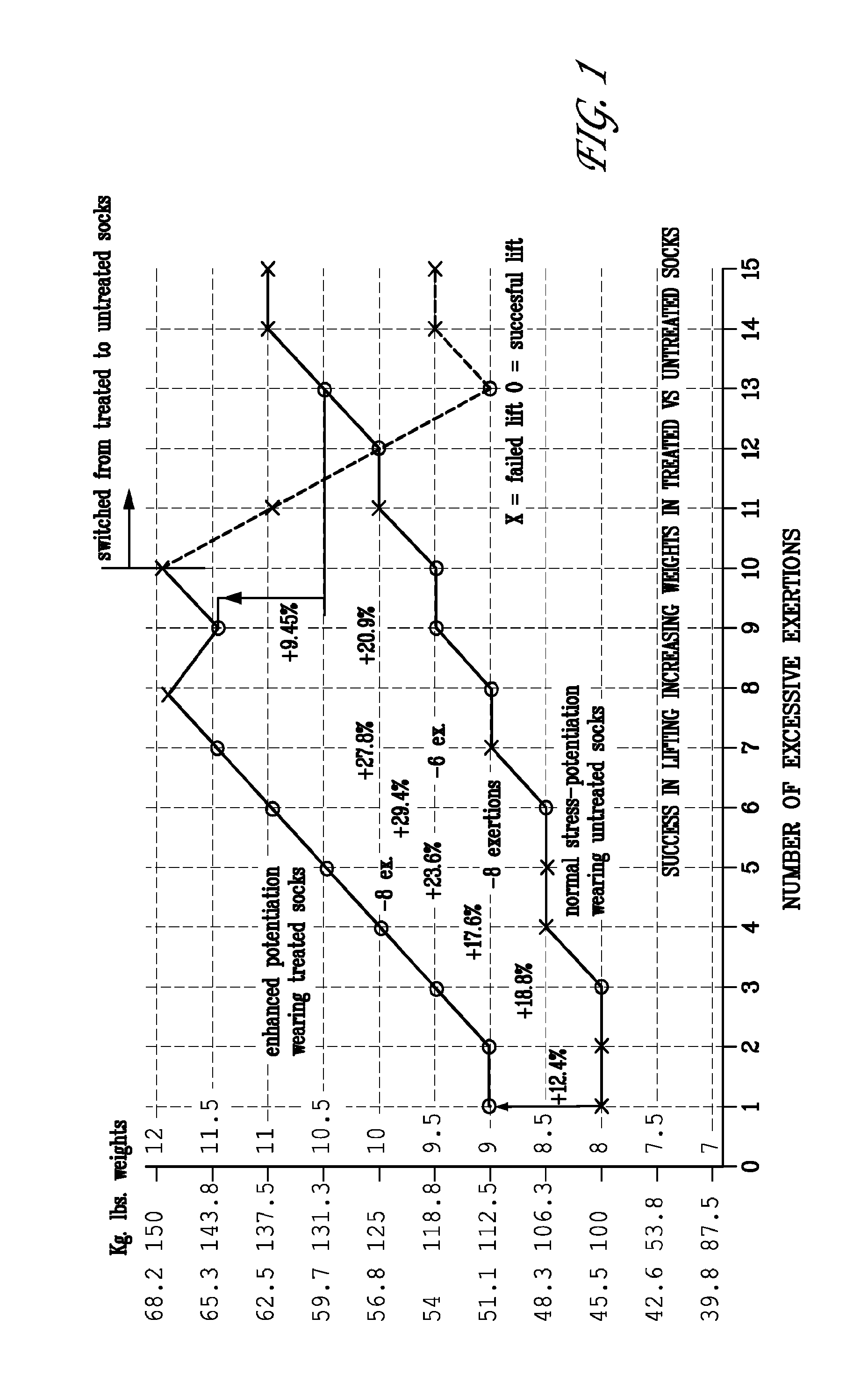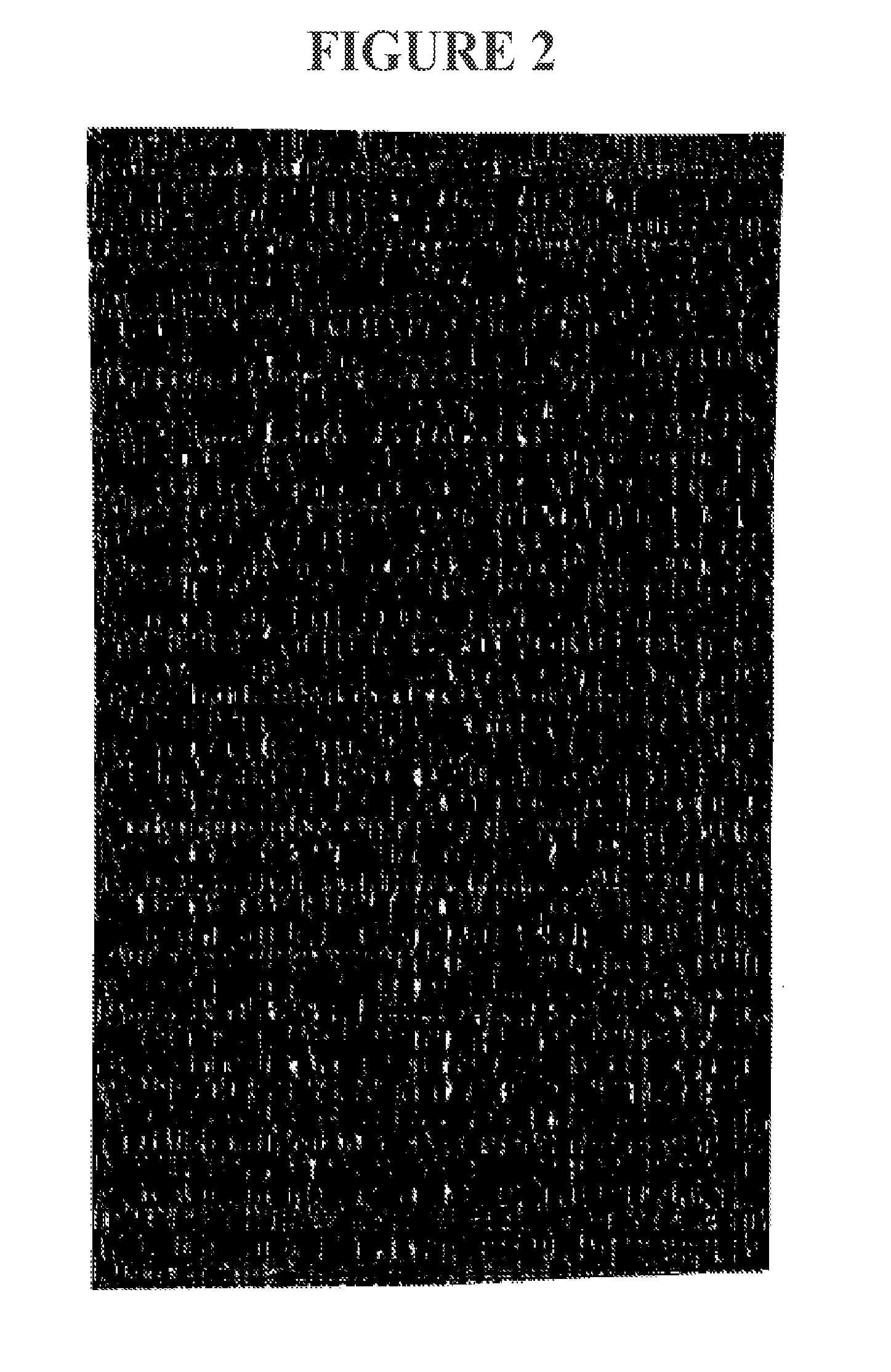Method of reducing the distortion of the electromagnetic field
- Summary
- Abstract
- Description
- Claims
- Application Information
AI Technical Summary
Benefits of technology
Problems solved by technology
Method used
Image
Examples
example 1
[0232]This example showed how treatment of socks with the method of the invention gave enhanced muscle potentiation without repeated exertions to stress-potentiate the leg muscles. It also showed that this test subject was able to lift 9.45% more weight than stress-potentiation alone made possible.
[0233]Control Socks: A pair of black, untreated men's socks (Style No. 16T-2240 Black 60 gram / pair Men's 7 inch Ankle height knitted in Thailand with 88% polyester / 10% cotton staples intimately blended Dri-release(R) yarns, and 2% Lycra spandex filament knitted in for stretch.
[0234]All sock pairs were removed from individual pair, clear polyethylene envelopes. The control socks were worn as received. The test socks were treated as below.
[0235]Test socks were imprinted for 12 hours by pulling them over molded plastic foot models that had the circuit pattern ink jet printed on paper taped to the bottoms and tops of the foot arch. After 12 hours at room temperature (˜70 F) the test socks were...
example 2
[0243]It was demonstrated that repeated maximal exertions in a leg extension test, prior to testing socks, could increase the average force exerted in a maximum isometric knee extension. The force measured in the first trials with untreated socks increased 5.5% in a second test. With treated socks, the third test was 5.5% higher, and the fourth was another 4% higher. Two weeks later, after the muscles had been fully potentiated by multiple maximal exertions another 4.4%, there was no significant further increase over seven trials with or without the treated socks. Therefore, multiple extreme exertions can push muscles to their maximum, and that the method of the invention increases potentiation below the maximum without requiring such extreme maximal exertions or electrical stimulation.
Determination of Leg Extension Muscle Potentiation by Maximal Exertion
[0244]On Day 1, the same test subject who tested hand grip and leg extension potentiation, with socks treated to enhance potentiat...
example 3
[0249]It was demonstrated that repeated maximal exertions in a leg extension test, prior to testing socks, increased the average force exerted in a maximum isometric knee extension to 331.4 N-m. The force measured in the first trials with untreated socks began at 274 N-m and increased to 289 N-m in a second test. With treated socks, the first test was 305 N-m and the second was 317 N-m. Two weeks later, after the muscles had been fully potentiated by multiple maximal exertions to the 331.4 N-m maximum, there was no significant increase wearing the treated socks. Therefore, the imprinting treatment of the invention increases potentiation below the maximum without requiring the prior maximal exertions or electrical stimulation.
Hand Grip Dynamometer Tests
[0250]A new pair of the same type socks above was treated 12 hours (overnight) and then tested for their effect on dominant hand grip strength 12 hours later. Maximal grip was exerted in each test, such that potentiation should occur i...
PUM
 Login to View More
Login to View More Abstract
Description
Claims
Application Information
 Login to View More
Login to View More - R&D
- Intellectual Property
- Life Sciences
- Materials
- Tech Scout
- Unparalleled Data Quality
- Higher Quality Content
- 60% Fewer Hallucinations
Browse by: Latest US Patents, China's latest patents, Technical Efficacy Thesaurus, Application Domain, Technology Topic, Popular Technical Reports.
© 2025 PatSnap. All rights reserved.Legal|Privacy policy|Modern Slavery Act Transparency Statement|Sitemap|About US| Contact US: help@patsnap.com



